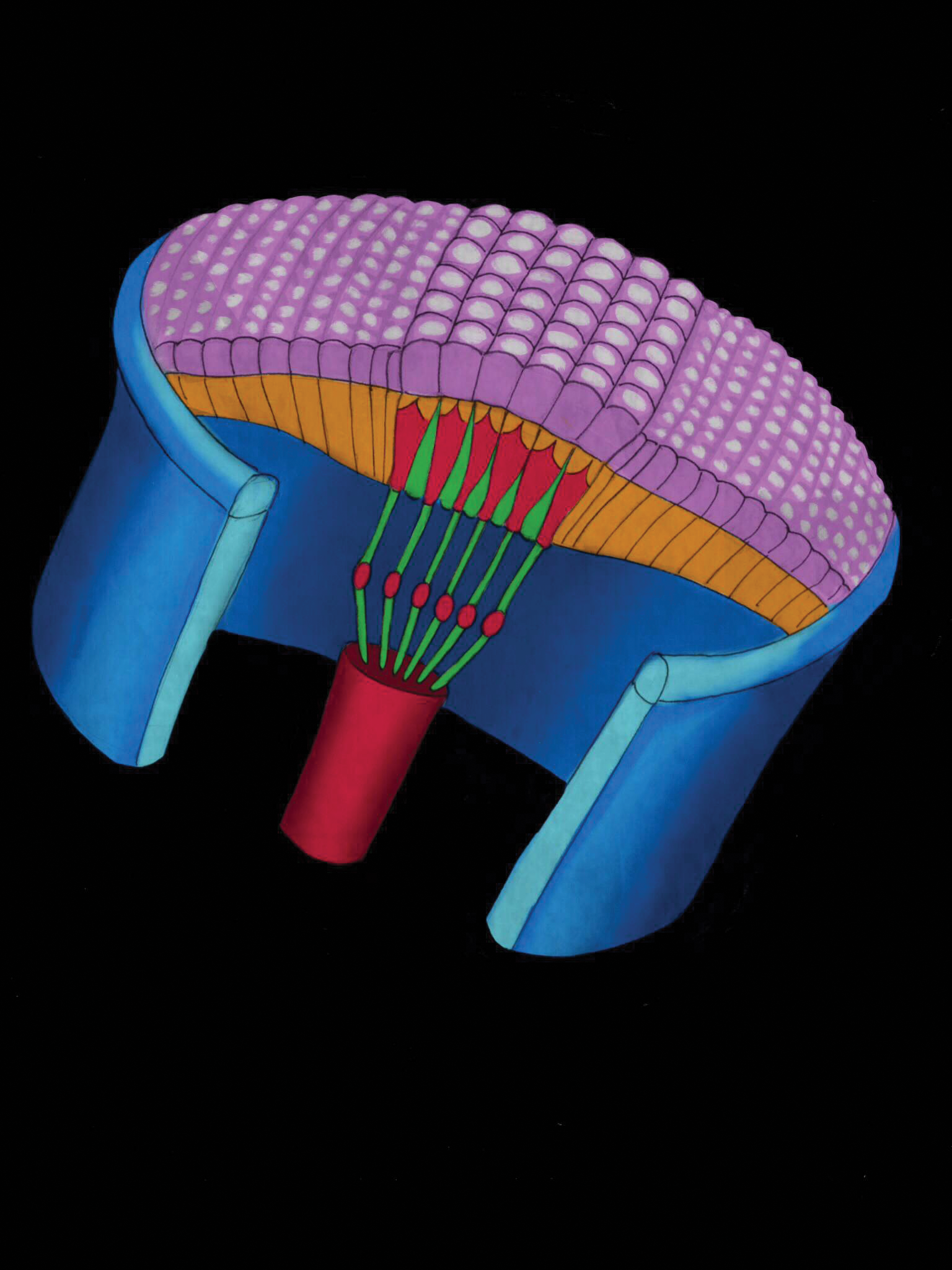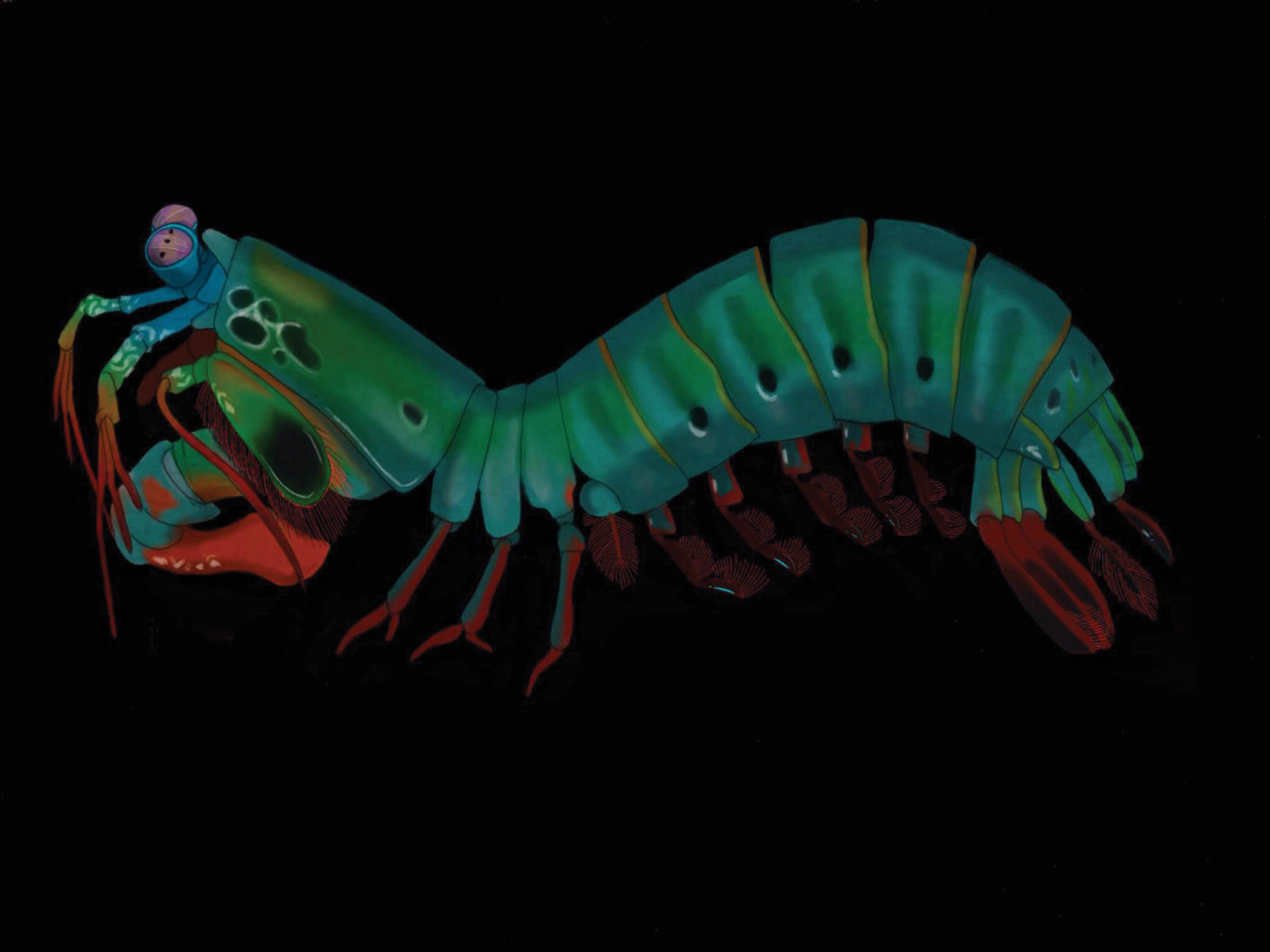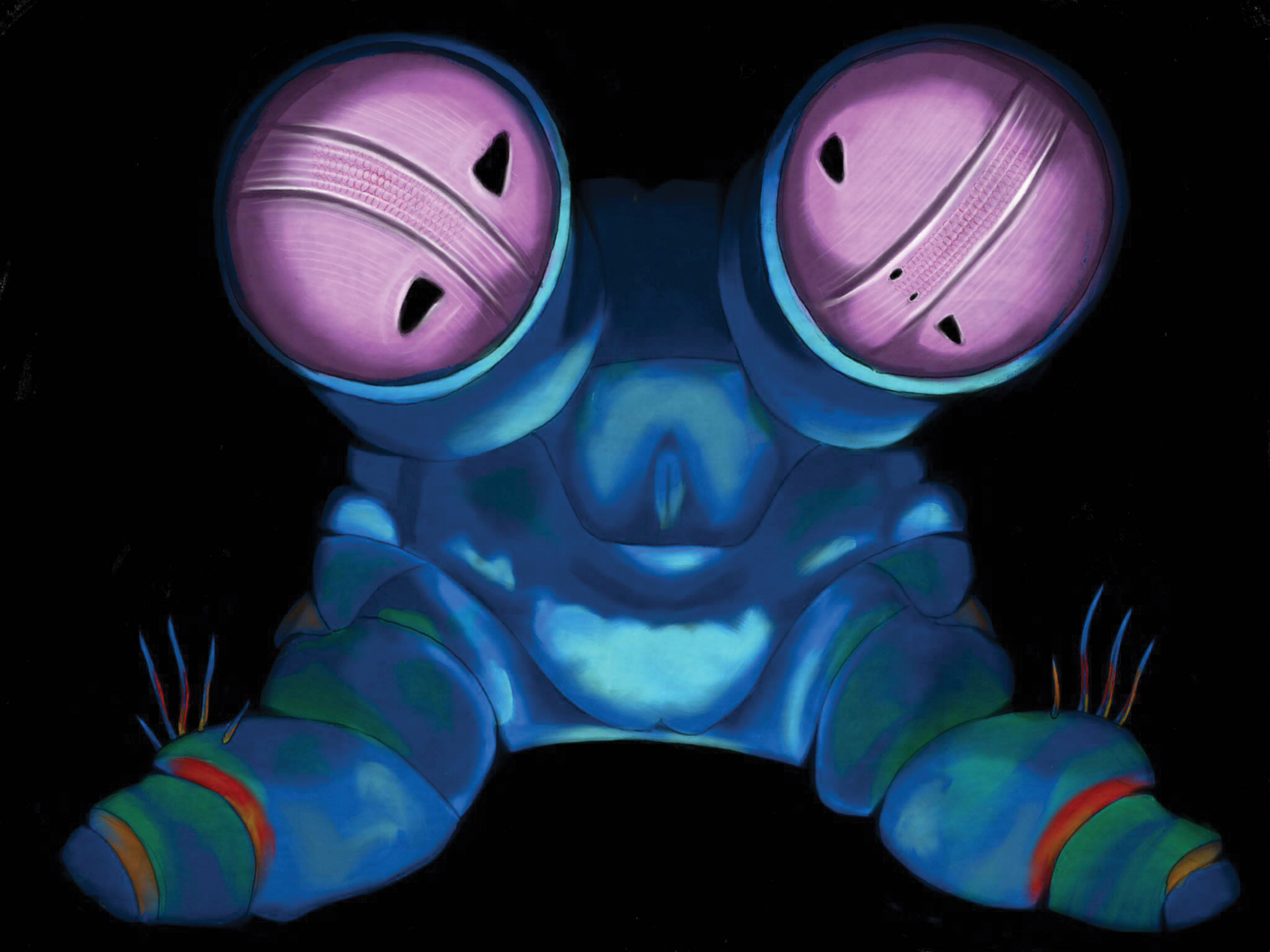Crawling on the bottom of the Indian and Pacific Ocean are many species of colorful stomatopod crustaceans, commonly known as mantis shrimp. For a species to occupy such a bustling and active environment, it must have some sort of evolutionary advantage, and although these stomatopod crustaceans possess many, one of their more valuable traits is their highly-advanced compound eyes [1].
While humans possess merely four types of photoreceptors in the retina, with three cones involved in color vision, mantis shrimps have up to sixteen photoreceptors, with at least eight dedicated to color vision [2][3]. This allows them to see not only the entire visible spectrum seen by humans (400 to 700 nanometer wavelengths), but also some light in the ultraviolet and infrared range, beyond human visual capacity. In essence, mantis shrimps can process light in the range of 300 to 720 nanometers (nm), and in this lies their advantage [4]. What appears to us as a world of gradient colors may contain an addition of burning infrared and glowing ultraviolet light to a stomatopod.
The ability to process a wide range of wavelengths comes from an intricate tier system of specialized photoreceptor cells within the compound eye [5]. Mantis shrimp's eyes are separated into three sections: dorsal hemisphere, midband (with six distinct rows of specialized cell groups), and ventral hemisphere, each with its own specific function [5]. Most of a mantis shrimp’s visual analysis happens in the midband region. The first four midband rows are utilized just for visual light and the two lower layers for polarized light, or light that is reduced to a single plane [4, 6]. The basic building blocks within these eyes are rhabdoms, which are constructed of eight different receptor cells [5]. In general, ultraviolet light is processed by the top tier (R8). Below R8, receptor cells from 7-1 process middle wavelengths. The unit containing optics, photoreceptors, and pigment cells is called an ommatidium, and each ommatidium is specialized in such a way that compound eyes, as a whole, can process a wide range of wavelengths as well as polarized light. Having many individually specialized ommatidia allows complex visual input to be processed immediately and sorted into parallel data channels right after it leaves the retina [5].
In an odd yet stark contrast to their incredibly designed eyes, the mantis shrimp is surprisingly inept at color discrimination [4]. A research study by Marshall et al. tested their ability to differentiate various hues and found that these creatures can only do so over a certain threshold. When difference in color wavelengths lowered to between 25 and 12 nm, the tested species could only differentiate between the two colors 50% of the time [4]. In a study published by The Optical Society, human test subjects were able to distinguish between the thickness of different films down to 2 nm in width using color vision [7]. This is a striking contrast to how poorly mantis shrimps performed. They can differentiate colors of widely different wavelength ranges, yet when this difference becomes smaller, they fail to discriminate colors at all [4]. In other words, while the mantis shrimp may be able to see a wide range of color wavelengths, their ability to distinguish between very similar colors is lacking [4]. A good way to visualize how an animal that has a superior number of photoreceptors may fail at telling colors of close wavelengths apart is to think of how humans perceive colored words. When the word “red” is written in the same color as its meaning, humans have no trouble naming its color; however, if the word “red” is written in blue, we take longer to identify its color. This is because when humans see “red,” we perceived its written meaning before discerning its actual color. Similarly, when a mantis shrimp sees a certain color or combination of colors in their environment, they see its meaning before they distinguish exactly what color(s) it is.

Mantis shrimp color discrimination is primitive and seems to lack the elegance expected in such a complicated biological arrangement. So what is the reason for this design, and how is it evolutionarily beneficial? Much like how humans use traffic signals to communicate messages and regulate traffic, mantis shrimp use colors as a signaling and communication mechanism. Humans use color and our ability to differentiate color as a way to embed meaning into objects, such as a chess game with black and white players. Comparatively, mantis shrimps can recognize meanings within varying color wavelengths [3]. When light enters the compound eye, different parts of the eye itself will process specific wavelengths, allowing for a streamlined analysis of visual input [5]. Shorter wavelengths are processed first, then longer wavelengths. After light passes through the retina, it is sorted into parallel streams of information and sent off to the brain. In humans, the retina decomposes light into only three color channels; however, because mantis shrimps simultaneously sort their visual information into more data streams, which also contain information concerning polarized light, this limits the amount of information their brains must process [5]. Such efficient design allows this species to maintain color constancy and speed of motor output in response to visual cues [4]. These are skills that are extremely important in a world where color and light can be skewed by water reflection as well as refraction due to their interaction with water molecules. Thus, while mantis shrimps are less than outstanding at discriminating color, they are extraordinary at recognizing the meaning of a range of wavelengths in nature and reacting quickly as well as precisely to their surroundings. Mantis shrimps may not need to distinguish between 700 nm red and 690 nm red, however, they do have to know exactly what those wavelengths mean to avoid a potential life or death situation.
Scuttling across the ocean floor, mantis shrimps paint colorful pictures of their surroundings, and while humans may wish to have an extended range of color for aesthetic reasons, these creatures use their gift for much more functional purposes. On the mantis shrimp's body are four main locations used for signaling communication [3]. These locations are meral spots (colored spots on their raptorial appendages), maxillipeds (appendages modified to help feeding), raptorial appendages (front appendages used for hunting and defense), and the orange spots on the last segment of the abdomen [3]. At each region, light is emitted/reflected in varying ranges, specifying the message being sent to members within a specific mantis shrimp species, as well as those in other mantis shrimp species [8]. Similar to human use of spoken, signed, or written language, mantis shrimps use wavelengths to communicate with each other. Different coloration of meral spots between individuals and species may help them with territorial and reproductive behaviors [9]. A mantis shrimp can also emit polarized light to warn others of its species that there is already an occupant in its burrow [10]. For an extremely aggressive and territorial species such as this, communication is crucial to survival [1]. One would not want to unintentionally wander into a neighbor shrimp's home, since the penalty for this is death by their powerful raptorial appendages, delivered with the same speed as a twenty-two caliber bullet [1]. However, there is one instance where a visitor might be welcomed in a more amicable way: courtship. When greeted by a female mantis shrimp, a male mantis shrimp does not attack [11]. This suggests some sort of signal communication between the two, most likely visual signals emitted from their color spots [3, 11]. In this way, recognizing colors of discrete wavelengths is crucial for discerning mating intentions from aggressive or territorial behaviors.
Another ability that mantis shrimps possess is reading color signals from certain types of reef animals, such as teleost fish [3]. Spying on other aquatic species, the mantis shrimp becomes a highly efficient predator and a crafty prey within their natural habitat. Evolution has favored the mantis shrimp's ability to quickly process light and derive meaning from their natural surroundings. Without this advantage, these creatures would lack the needed precision to strike prey and fail at distinguishing the difference between aggression signals and mating signals.
Mantis shrimps perceive visual information in entirely different and unique ways compared to humans. Through evolution, these crustaceans have come to possess some of the most complex eyes in the animal kingdom [4]. The capacity for beauty this species possesses may fool some into thinking they are creatures of grace. However, their superior color vision gives them an incredible advantage in the competitive reef environment. While there have been many in-depth studies about the compound eye’s structure and how information is processed at its basic ommatidia units, there is still much to learn about these creatures and how they process visual signals beyond the compound eyes. Nonetheless, some research suggests possibilities for applying mantis shrimps’ eye structure to modern technology that can detect damaged muscles and cancer cells [10]. With more time, perhaps the mantis shrimp’s aquatic vision can be applied to help humans on land.

References
- National Aquarium. Peacock Mantis Shrimp_Odontodactylus scryllarus. Retrieved from http://www.aqua.org/explore/animals/mantis-shrimp
- Dartnall, H., J., A., Bowmaker, J., K., Mollon, J., D. (June 1983). Human Visual Pigments: microspectrophotometric results from the eye of seven persons. Retrieved from: http://rspb.royalsocietypublishing.org/content/royprsb/220/1218/115.full.pdf
- Chuan-Chin Chiao, Cronin, M., Marshall, J. (August 2000). Eye design and color signaling in a stomatopod crustacean Gonodactylus smithii. Retrieved from http://search.proquest.com/docview.232164762/fulltext/EFE9139DE1E54A8BPQ/4?accountid=14784
- Thoen, H., How, M., Chiou, T-H., Marshall, J. (January 24, 2014). A Different Form of Color Vision in Mantis Shrimp. Retrieved from http://science.sciencemag.org/content/343/6169/411.full
- Cronin, T., Marshall, J. (April 2001). Parallel Processing and Image Analysis in the Eyes of Mantis Shrimps. Retrieved from http://www.journals.uchicago.edu/doi/10.2307/1543312
- The Physics Classroom. Light Waves and Color_ Lesson 1: How Do We Know Light is a Wave? _ Polarization. Retrieved from: http://www.physicsclassroom.com/class/light/Lesson-1/Polarization
- Peterhänsel, S., Laamanen, H., Lehtolahti, J., Kuittinen, M., Osten, W., Tervo, T. Human color vision provides nanoscale accuracy in thin-film thickness characterization. Retrieved from: https://www.osapublishing.org/optica/abstract.cfm?uri=optica-2-7-627
- Cronin, T., Marshal, J., (May 11, 1989). A retina with at least ten spectral types of photoreceptors in a mantis shrimp. Retrieved from http://web.qbi.uq.edu.au/ecovis/Images/Justin/1989%20A%20retina%20with%20at%20least%20ten%20spectral%20types.pdf
- Caldwell, R., L. (1975). Ecology and Evolution of Agonistic Behavior in Stomatopods. Retrieved from: http://www.digizeitschriften.de.offcampus.lib.washington.edu/dms/img/?PID=PPN34557155X_0062|LOG_0068&physid=PHYS_0273#navi
- Kennerson, E., Boyle, C. (November 2016). The Snail-Smashing, Fish-Spearing, Eye-Popping, Mantis Shrimp. Retrieved from: https://ww2.kqed.org/science/2016/11/15/the-snail-smashing-fish-spearing-eye-popping-mantis-shrimp/
- Caldwell, R., Dingle, H. (June 1972). Reproductive and maternal behavior of the mantis shrimp gonodactylus bredini manning (crustacea: stomatopoda). Retrieved from: http://www.journals.uchicago.edu/doi/pdfplus/10.2307/1540319
